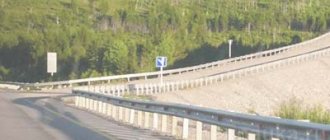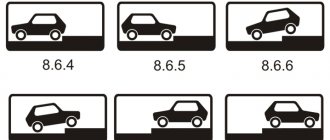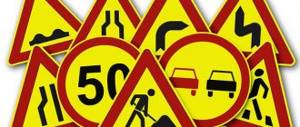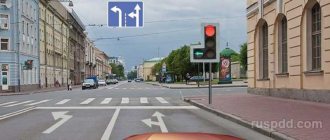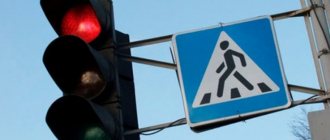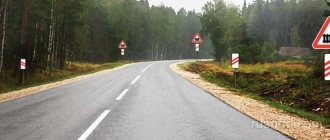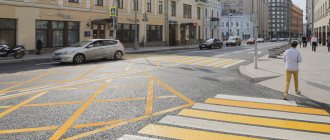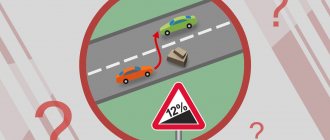If there are signs and markings on the road that contradict each other, then the driver must clearly navigate the situation and know what to give priority to. They may contradict each other in the event of an accident or during repair work on the road. Therefore, the driver must be careful not to create an emergency situation and navigate short-term traffic changes.
What is priority: sign or marking?
In order not to be mistaken with the primacy of signs on the road, you should distinguish between the types of road signs and markings. They can be permanent or temporary. But in any case, according to the rules, the driver must be able to see them at any time of the day. Signs should not be obscured by billboards or trees. Particular attention should be paid to signs that are installed illegally. They have no force and the driver should not take this information into account. Illegal signs include: those attached to a lamp post or tree using duct tape or tape. Such pointers must be ignored.
Temporary road signs and markings
It is easy for a motorist on the road to distinguish temporary road signs from permanent ones. Temporary signs have a yellow background, permanent signs have a white background. According to the traffic rules, there must be a sign under the temporary signs indicating the territory of influence of this informer and the distance to the problem area. Usually, at the end of the segment, sign 3.31 is installed, which removes all restrictions that were in force before it.
The temporary marking differs only in color - it is orange. Temporary indicators always take precedence over permanent ones, since they indicate the need for a certain movement in a specific situation. In this case, stationary signs are usually removed or covered so that they do not confuse drivers. Temporary signs are easier to install and can also be easily dismantled.
Permanent road signs and markings
Permanent signs are installed for a long time. They are designed to show information that will be relevant for a long time, regardless of external factors. Permanent signs must be installed in a specially prepared recess, which is then filled with concrete. Once the concrete has hardened, earth is poured around the sign. Unlike temporary signs, permanent signs inform about the features of movement on a given section of the road in the long term. Permanent markings have a white main background color inside the border.
If there are temporary and permanent informers on the site at the same time, then according to the traffic rules, temporary signs have priority for the driver, since they inform about the changed situation on this section of the road.
Important! If the lines painted on the road contradict the signs, then according to the traffic rules the latter have priority, while the markings are always of secondary importance.
Prioritization
If you prioritize, taking into account temporary and permanent signs, then the temporary road sign comes first, followed by the permanent one. In third place in terms of priorities is temporary marking and only then permanent marking.
On a road that has several lanes, according to traffic regulations, the sign must be located not only on the side, but also on the road so that drivers moving in the middle of the stream have access to this information.
Priority level
Based on the traffic rules, it is easy to determine what is a priority, a road sign or markings.
If the meaning of temporary road signs and stationary ones contradict each other, motorists must be guided by the temporary signs.
Temporary road signs always have the highest priority level. Therefore, they are quite easy to install and dismantle if necessary.
In case of an emergency or short-term road work, there is no alternative to its use. The list, in descending order of priority, of the road arrangement elements looks like this:
- temporary road signs;
- permanent road signs;
- temporary road markings;
- permanent road markings.
The traffic rules state:
- A temporary sign is more important than all elements of road construction.
- If a sign contradicts the markings, including temporary ones, or when they are not sufficiently distinguishable, then the sign is more important.
- In cases where permanent marking lines and temporary marking lines contradict each other, drivers must be guided by the meaning of the temporary markings.
- Temporary markings take precedence over permanent markings.
If a situation arises that is unclear to the driver, what is more important on the road, a road sign or markings, it is important to remember the list of priorities of road design elements and note that temporary markings cannot be more important than permanent road signs.
An example of contradictions between road signs and markings
Sometimes a traffic sign clearly defines the direction of movement of the vehicle, for example, only straight, and in accordance with the road markings you can drive straight or make a maneuver to the right or left.
In this case, the driver must give priority to the sign and drive according to its rules.
Since the updated traffic rules clearly define what is more important on the road, the road sign or the markings.
But if there is no sign, then you should move along the road markings.
Examples of contradictions between signs and markings
There are several most common options when the two pointers in question contradict each other. Most often, permission is given to overtake vehicles in the oncoming lane if there is a double solid line and a temporary informer 4.2.2. Usually this combination is used when repairing a road. In this case, the priority will be to allow overtaking, despite the double solid line. There are other options for controversial situations.
Overtaking at sign 3.20 and markings 1.5
Plate 3.20 means that overtaking is prohibited on this section of the road. Marking 1.5 is a broken line allowing overtaking and detour. A broken line is used on two-lane roads as well as on three-lane roads to indicate lanes. Despite the fact that such a line is a “center line,” on two-lane roads it can be crossed and overtaken. But only if there are no additional signs that contradict the lines marked on the road.
If these conflicting information messages are combined on one section of the road, then the driver should not overtake, focusing on the prohibitory sign. But the markings in this case are of particular importance; they allow overtaking or detour:
- slow-moving vehicles;
- horse-drawn transport;
- motorcycles without trailers.
It is the dotted strip that indicates the effect of these exceptions. In this situation, it will not be overtaking, but rather a detour.
Overtaking at sign 3.21 and markings 1.1
The situation is the opposite of the previous one. In this case, symbol 3.21 indicates the end of the overtaking zone, and marking 1.1 is a solid line that cannot be crossed, which means you cannot overtake. In this case, the line will have priority, since the sign does not indicate that overtaking is allowed. It simply indicates the end of the no-overtaking zone. By and large, these informers do not contradict each other, but complement each other.
Important! In bad weather conditions and poor visibility, the driver may not notice the solid line, but will first pay attention exclusively to indicator 3.21. In this case, it is necessary to use regulatory documents to prove the innocence of the motorist.
Permanent
Permanent signs located on traffic lanes contain information necessary for the movement of motorists.
The distinctive features compared to the temporary variety are that:
- They are applied with paint of a different color. Such signs cannot be yellow.
- A different installation method is used.
To install these signs, you need to dig a hole that has a certain level of depth. The direction is determined directly on the ground. The base of the sign is placed in the hole, after which it is filled with concrete. At the final stage, you will need to let the concrete harden and fill the hole with soil. In the future, such a sign will be almost impossible to move in relation to each other and other directions. Priority is due to the fact that it is installed for a long period of time.
The paragraph regarding permanent marking indicates that it is also applied for a long time. The design is realized using a thick layer of paint. White color scheme is used. Over the past year, traffic tickets have often asked questions regarding this marking. It will be almost impossible to erase it from the road surface. It is used for the safe movement of vehicles along the highway. Installed on a specific section of the route. The symbols used are similar to those used when applying temporary markings. However, the application in the situation under consideration will be somewhat broader.
What to do if there are contradictions?
First of all, the driver should calm down and not panic. Only in this case will it be possible to make the right decision. If there is an obvious contradiction between the sign and the markings, the priority is always the temporary sign, since it indicates the desired actions depending on specific circumstances (road repairs, accidents, weather conditions, emergency situations). The markings in relation to the sign are always secondary, and this is conveyed to drivers during training at a driving school. It is important to remember this material and use it.
Responsibility for failure to comply with priorities
If a motorist does not comply with priorities, he faces administrative punishment in the form of a fine. The fee for failure to comply with the requirements of markings or road signs is 500-1500 rubles.
If the sign required you to stop, turn around or turn, the fine increases from 1000 rubles to deprivation of your driver’s license. If the driver believes that he was fined unlawfully and did not violate the priority, then within 10 days he has time to file a complaint and protest the inspector’s decision.
Conflicting information on the road can confuse even experienced drivers. But traffic regulations have clear instructions in this regard: a temporary sign is a priority, since it indicates the necessary actions depending on specific changed road conditions. Most often there is a contradiction with the prohibition and permission of overtaking. If there is a temporary sign on the road prohibiting overtaking, the markings in this case do not matter. It is better for the driver to take his time and not cross the line.
Signs against markings
It’s unlikely that anyone wants to pay a fine for a stop line when there is a pedestrian crossing ahead, or face protocols for changing lanes.
Chapter 8 of Appendix 1 of the current traffic rules states that in the presence of contradictory signs, drivers should focus on the temporary ones. This is about the question of what to believe, temporary or permanent signs. The correct answer is temporary.
This allows you to set certain priorities. Namely:
- a temporary sign dominates the road;
- it is followed by a permanent sign;
- only then comes the temporary marking;
- and the least priority will be permanent marking.
There is also chapter 1 of appendix 2 in the traffic rules, which says:
- if road signs, including temporary ones, contradict the markings, then the driver’s emphasis is on the sign;
- if the temporary marking does not correspond to the permanent marking, then the temporary marking will be the reference.
Based on this, appropriate conclusions can be drawn.


